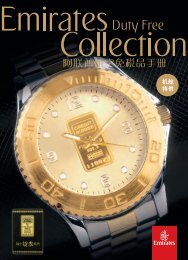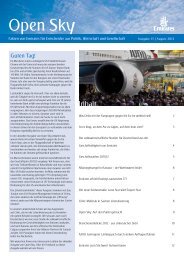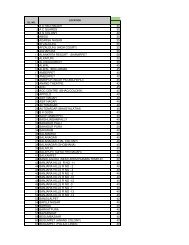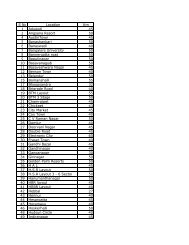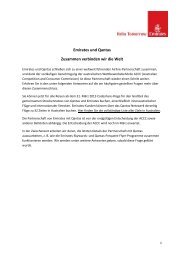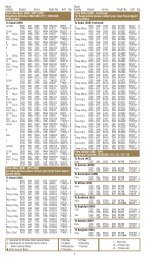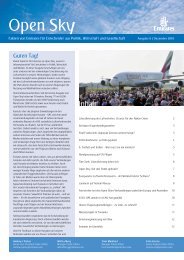Annual Report 2008-2009 - Emirates.com
Annual Report 2008-2009 - Emirates.com
Annual Report 2008-2009 - Emirates.com
You also want an ePaper? Increase the reach of your titles
YUMPU automatically turns print PDFs into web optimized ePapers that Google loves.
2. Summary of significant accounting policies (continued)<br />
<strong>Emirates</strong>’ criteria to account for a derivative financial instrument as a hedge include:<br />
formal documentation of the hedging instruments, hedged items, hedging objective, strategy and basis of measuring effectiveness all<br />
of which are prepared prior to applying hedge accounting; and<br />
<br />
documentation showing that the hedge effectiveness is assessed on an ongoing basis and is determined to have been highly effective<br />
in offsetting the risk of the hedged item throughout the reporting period.<br />
Changes in the fair value of derivatives that are designated and qualify as fair value hedges and that are highly effective, are recorded in<br />
the consolidated in<strong>com</strong>e statement, along with any changes in the fair value of the hedged asset or liability that are attributable to the<br />
hedged risk. This accounting treatment is discontinued when the fair value hedging instrument expires or is sold, terminated or exercised,<br />
or the hedge no longer meets the criteria for hedge accounting.<br />
Changes in the fair value of derivatives that are designated and qualify as cash flow hedges and that prove to be highly effective in<br />
relation to the hedged risk, are recognised in the fair value reserve in equity. When the forecasted transaction results in the recognition of<br />
an asset or of a liability, the gains and losses previously deferred in equity are transferred from equity and recognised in profit or loss in<br />
the same period during which the asset or liability affects profit or loss. In all other cases, amounts deferred in equity are transferred to<br />
the consolidated in<strong>com</strong>e statement in the period during which the forecasted transaction affects the consolidated in<strong>com</strong>e statement and<br />
are presented in the same line item as the gains and losses from hedged items.<br />
When a cash flow hedging instrument expires or is sold, terminated or exercised, or when a hedge no longer meets the criteria for hedge<br />
accounting under IAS 39, any cumulative gain or loss existing in equity at that time is retained in equity and is ultimately recognised in the<br />
consolidated in<strong>com</strong>e statement when the forecasted transaction occurs. If a forecasted transaction is no longer expected to occur, the<br />
cumulative gain or loss that was reported in equity is immediately transferred to the consolidated in<strong>com</strong>e statement. The gain or loss on<br />
the ineffective portion is recognised in the consolidated in<strong>com</strong>e statement.<br />
Changes in the fair value of derivative instruments that do not qualify for hedge accounting are recognised immediately in the<br />
consolidated in<strong>com</strong>e statement.<br />
Inventories<br />
Inventories are stated at the lower of cost and estimated net realisable value. Cost is determined on the weighted average cost basis with<br />
the exception of consumer goods inventory which is determined on a first-in-first-out basis.<br />
Trade receivables<br />
Trade receivables are initially recognised at fair value and subsequently measured at amortised cost using the effective interest method,<br />
less provision for impairment. Where there is objective evidence of amounts that are not collectible, a provision is made for the difference<br />
between the carrying amount and the present value of the estimated future cash flows, discounted at the original effective interest rate.<br />
Borrowings<br />
Borrowings are recognised initially at fair value, net of transaction costs incurred. Borrowings are subsequently stated at amortised cost<br />
with any difference between the proceeds (net of transaction costs) and the redemption value recognised in the consolidated in<strong>com</strong>e<br />
statement over the period of the borrowings using the effective interest method.<br />
Employee end of service benefits<br />
<strong>Emirates</strong> operates or participates in various end of service benefit plans, which are classified either as defined contribution or defined<br />
benefit plans.<br />
A defined contribution plan is a pension scheme under which <strong>Emirates</strong> pays fixed contributions and has no legal or constructive<br />
obligation to pay further contributions if the fund does not hold sufficient assets to settle the benefits relating to the employees service in<br />
the current and prior periods. Contributions to the pension fund are charged to the consolidated in<strong>com</strong>e statement in the period in which<br />
they fall due.<br />
A defined benefit plan is a plan which is not a defined contribution plan. The liability recognised in the consolidated balance sheet for<br />
defined benefit plan is the present value of the defined benefit obligation at the balance sheet date less the fair value of plan assets at that<br />
date, together with adjustments for unrecognised past-service costs and unamortised actuarial gains and losses. The defined benefit<br />
obligation is calculated by independent actuaries using the projected unit credit method. The present value of the defined benefit<br />
obligation is determined by discounting estimated future cash outflows using market yields at the balance sheet date of high quality<br />
corporate bonds that have terms to maturity approximating the estimated term of the post-employment benefit obligations.<br />
081





